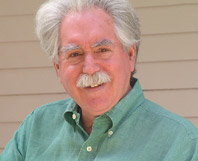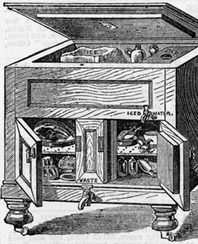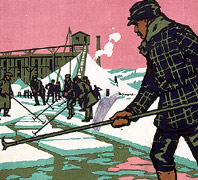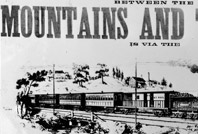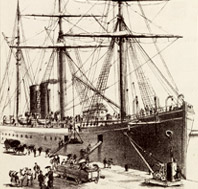The Conquest of Cold
by Tom Shachtman
Refrigerated railroad cars played a fateful role
in the final subjugation of native cultures in the American
West.
Artificially produced refrigeration has been the least noted
of the three technological breakthroughs of great significance
to the growth of cities that came to the fore between the
1860s and the 1880s. More emphasis has been given to the role
played by the elevator and by the varying means of
communication, first the telegraph and later the telephone.
The elevator permitted buildings to be erected higher than the
half-dozen stories a worker or resident could comfortably
climb; telegraphs and telephones enabled companies to locate
managerial and sales headquarters at a distance from the
ultimate consumers of goods and services.
Refrigeration had equal impact, allowing the establishment of
larger populations farther than ever from the sources of their
food supplies. These innovations helped consolidate the
results of the Industrial Revolution, and after their
introduction, the populations of major cities doubled each
quarter century, first in the United States—where
technologies took hold earlier than they did in older
countries—and then elsewhere in the world.
An index of civilization
A spate of fantastic literature also began to appear at this
time; in books such as Jules Verne's
Paris in the Twentieth Century, set in 1960, indoor
climate control was mentioned, though its wonders were not
fully explored. From the mid-19th century on, most visions of
technologically rich futures included predictions of control
over indoor and sometimes outdoor temperature.
In addition to flocking to cities for jobs, Americans also
became urbanites in the latter part of the 19th century
because there seemed to be fewer hospitable open spaces into
which an exploding population could expand. Large areas of the
United States were too hot during many months of the year to
sustain colonies of human beings; these included the Southwest
and parts of the Southeast, with their tropical and
semitropical climates, deserts, and swamps. Looked at
in retrospect, the principal limitation on people settling in
those areas was the lack of air-conditioning and home
refrigeration.
In the second half of the 19th century, the use of cold in the
home became an index of civilization. In New York, 45 percent
of the population kept provisions in natural-ice home
refrigerators. It was said in this period that if all the
natural-ice storage facilities along the Hudson River in New
York State were grouped together, they would account for seven
miles of its length. Consumption of ice in New York rose
steadily from the 100,000 tons-per-year level of 1860 toward a
million tons annually in 1880. But while the per capita use of
ice in large American cities climbed to two-thirds of a ton
annually, in smaller cities it remained lower, a quarter of a
ton per person per year.
Ice age
When New York apple growers felt competitively squeezed by
western growers who shipped their products in by refrigerated
railroad car, they hired experts to improve the quality of
their own apples. A specialist was hired to help prevent blue
mold, a disease affecting oranges, so that California's
oranges would be more appealing to New York consumers than
oranges from Central and South America.
Believing there were not enough good clams to eat on the West
Coast, the city fathers of San Francisco ordered a
refrigerator carload of eastern bivalves to plant in San
Francisco Bay, founding a new industry there. Commenting in
1869 on the first refrigerated railroad-car shipment of
strawberries from Chicago to New York,
Scientific American predicted, "We shall expect to see
grapes raised in California and brought over the Pacific
Railroad for sale in New York this season."
The conventional view is that the "iron horse" finally killed
off the "red man"; but one could with as much justification
say that it was the refrigerator.
The desire for refrigeration continued to grow, almost
exponentially, but the perils associated with using sulfuric
acid, ammonia, ether, and other chemicals in vapor compression
and absorption systems remained a constraint on greater use of
artificial ice, as did the high costs of manufacturing ice
compared with the low costs of what had become a superbly
efficient natural-ice industry.
Artificial refrigeration finally began to surpass natural-ice
refrigeration in the American West and Midwest in the
mid-1870s. In the space of a few years, as a result of the
introduction of refrigeration, hog production grew 86 percent,
and the annual export of American beef (in ice-refrigerated
ships) to the British Isles rose from 109,500 pounds to 72
million pounds. Simultaneously, the number of refrigerated
railroad cars in the United States skyrocketed from a few
thousand to more than 120,000.
The rise of refrigeration
Growth of the American railroads and of refrigeration went
hand in hand; moreover, the ability conveyed by refrigeration
to store food and to transport slaughtered meat in a
relatively fresh state led to huge, socially significant
increases in the food supply, and to changes in the American
social and geographical landscape.
"Slaughter of livestock for sale as fresh meat had remained
essentially a local industry until a practical refrigerator
car was invented," Oscar Anderson's 1953 historical study of
the spread of refrigeration in the United States reported. And
because refrigeration permitted processing to go on
year-round, hog farmers no longer had to sell hogs only at the
end of the summer, the traditional moment for sale—and
the moment when the market was glutted with harvest-fattened
hogs—but could sell them whenever they reached their
best weight.
In Great Britain, the Bell family of Glasgow, who wanted to
replace the natural-ice storage rooms on trans-Atlantic ships
with artificially refrigerated rooms that could make their own
ice, sought advice from another Glaswegian, Lord Kelvin. Lord
Kelvin assisted the engineer J. Coleman in designing what
became the Bell-Coleman compressed-air machine, which the
Bells used to aid in the transport of meat to the British
Isles from as far away as Australia. Because of refrigeration,
every region of the world able to produce meat, vegetables, or
fruit could now be used as a source for food to sustain people
in cities even half a world away. Oranges in winter were no
longer a luxury affordable only by kings.
A fateful association
Refrigeration in combination with railroads helped cause the
wealth of the United States to begin to flow west, raising the
per capita income of workers in the food-packing and
transshipment centers of Chicago and Kansas City at the
expense of workers in Boston, New York, and Philadelphia.
Refrigeration enabled midwestern dairy farmers, whose cost of
land was low, to undercut the prices charged for butter and
cheese by the dairy farmers of the Northeast. Refrigeration
made it possible for St. Louis and Omaha packers to ship
dressed beef, mutton, or lamb to market at a lower price per
pound than it cost to ship live animals, and when the railroad
magnates tried to coerce the packers to pay the same rate for
dressed meat as for live animals, the packers built their own
refrigerated railcars and forced a compromise.
The enormous jump in demand for meat, accelerated by
refrigerated storage and transport, spurred ranchers and the
federal government to take over millions of acres in the
American West for use in raising cattle. This action brought
on the last phase of the centuries-long push by European
colonizers to rid America of its native tribes, by forcing to
near extinction the buffalo and the Native American tribes
whose lives centered on the buffalo. The conventional view of
American history is that it was the "iron horse" that finally
killed off the "red man"; but one could with as much
justification say that it was the refrigerator.

